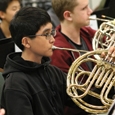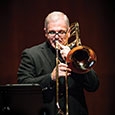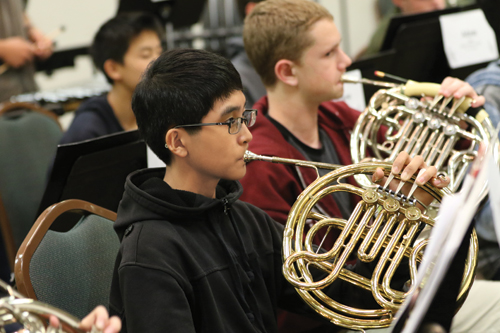
Developing skill and facility in the extreme upper and lower registers of the instrument is a challenge for brass players. While most students learn with relative ease to cover the two octaves or so presented in first- and second-year band methods, extending range beyond this requires more intentional and targeted effort. The required coordination of accurate hearing, tongue placement, air speed and direction, and muscular development presents a number of potential obstacles to range extension for young players. Happily, these obstacles can be overcome with regular and correct practice; below are five broad, guiding principles to inform that practice.
Ear Training
Successful playing in extreme registers requires first of all that the player accurately hear the desired pitch. In most brass instruments’ middle registers (the horn is a notable exception) the partials of the overtone series are far enough apart that students with only somewhat accurate notions of pitch can often find the right notes by pressing the right fingers and hoping for the best. In these cases the natural tendencies of the instrument have a way of guiding the embouchure to the right place.
In the upper register, though (and beginning in the middle register of the horn), the partials for each fingering or slide position are much closer together, and above the seventh partial they are separated only by steps and then by half-steps. At this point in the range a student who is not accurately hearing the desired pitches before playing will be much less likely to find the correct note. Students must accurately conceptualize the correct pitch, at which point a clear signal is sent from the brain to the embouchure, which, if technique is correct and the student has undergone sufficient physical development, then produces the desired note.
Have students sing and buzz before playing; this will help to identify and correct pitch deficiencies, while also helping to promote a musical approach to the extended upper range. Note that muscle memory is no substitute for ear training, as the tactile sensations of the embouchure are quite fickle.
Low range development also requires that students have a good ear, although for different reasons than the high register. Here the partials are far apart and finding the correct one is rarely difficult. However, bending the pitch of low notes is much easier than in the upper register, and it can happen inadvertently if students do not hear the note correctly before playing. Additionally, most people naturally hear high pitches more accurately than low ones; students will have to train themselves to have good pitch perception in the lower register, particularly as the playing range extends below the vocal range.
The importance of accurate pitch perception for extended range development cannot be overstated. Students with accurate internal pitch will be much better able to develop facility and accuracy throughout the tonal range. Those with lacking pitch perception will struggle.
Use Vowels
Playing in extended registers also requires that the player make significant changes in air speed and direction. While this is an oversimplified explanation of the relationship of air speed and volume to pitch production, in practice I find it helpful to think of blowing faster air in the higher register and slower air in the lower register, and to think of air volume only with regard to dynamic level. Changes in air speed are largely accomplished by changing the vowel shape used when playing.
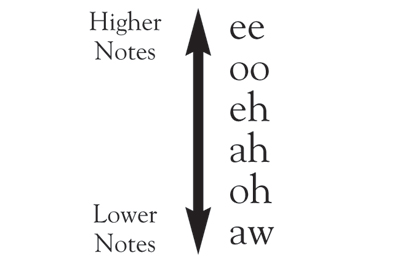
There is a certain mind trick aspect to these vowels, and there is more going on with these changes in oral cavity shape than differences in the air speed. Certainly there are minute adjustments the tension and use of the facial musculature, and the direction of the air shifts as well, being directed more toward the mouthpiece throat in the low register, and toward the rim in the high register. Downstream embouchures are much more common than upstream ones, but in both cases the air is directed toward the rim for higher notes and toward the throat for lower notes.
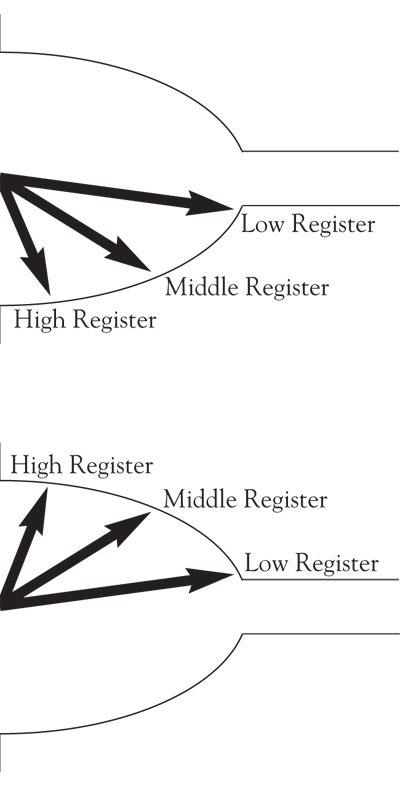
The great thing about the use of vowels is that these adjustments happen without the player having to think about them consciously. Instead, students can simply hear the pitch and then imagine singing it using the appropriate articulation and vowel (again, a rather musical approach), and allow these minute changes to take place automatically, on a subconscious level. Over time the player will develop the needed strength and coordination to develop and extend range simply by continuing to play in the extreme registers on a daily basis.
Be Willing to Sound Bad
With a few exceptions, students who begin working to extend their tonal ranges will find that the new notes being attempted do not sound particularly good at first. This presents a psychological obstacle for some students, who might fear that the poor sound indicates that they are doing something wrong or who simply do not like to play notes that sound bad. While thinking about facial musculature while playing is usually unproductive or even harmful, it is nevertheless true that the musculature and tissues must develop the necessary strength and flexibility to produce those higher and lower notes. For most students this will take some time to achieve, and the initial sounds will not be especially good. As long as students are not using excessive tension or making extreme embouchure shifts, they should be encouraged to continue working through the bad sounds. With time and practice the sound will improve.
Practice Room Range versus Performance Range
Because new notes at the end of the range tend to sound poor, as a rule, I never want to use the highest or lowest notes I can almost play in a performance. Therefore, in the practice room I will try to extend both the upper and lower ranges at least a fifth beyond what I can play consistently, comfortably, and with a good sound. This is illustrated below.
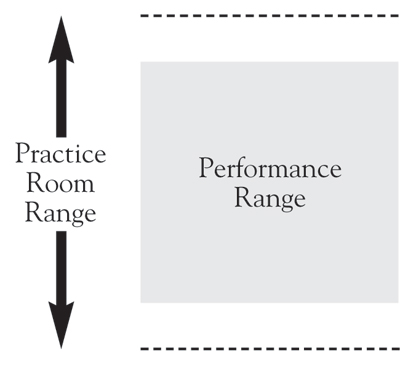
There are limits to this, particularly with the lowest notes on the instrument, and pushing past the point of pain or excessive shifting should be avoided. Still, extending past the performance range strengthens those usable notes even further, and over time that range increases, which likewise extends the practice room range. Using this method, the poorer sounds that tend to accompany the first forays into extended ranges are anticipated and even welcomed, with the expectation that regular practice will eventually lead to adding these notes to the performance range.
Daily, Systematic Effort
Range extension requires daily and systematic effort. I have avoided suggesting particular exercises in this article because there are a number of published routines and exercises that can promote healthy range development. The methods of Max Schlossberg (1873-1936), Emory Remington (1892-1971), and Robert Marsteller (1918-1975) come to mind, and many professional players and college and university faculty members have made effective daily routines available online. Ensemble exercises for range extension can be developed and used as well, although the focus here has been upon individual practice.
Whatever exercises are used for range development, progress will not occur if they are used only occasionally or in an erratic fashion. Slurring exercises through the harmonic series, scales and arpeggios throughout the range, and even vocalises and other legato exercises in extreme registers should be used each day and in a regular, systematic fashion in order to promote healthy, steady development of extreme registers. Incorporating all of the principles presented here into this practice will promote slow and steady but ultimately simple, practical, and musical development of an extended tonal range.
